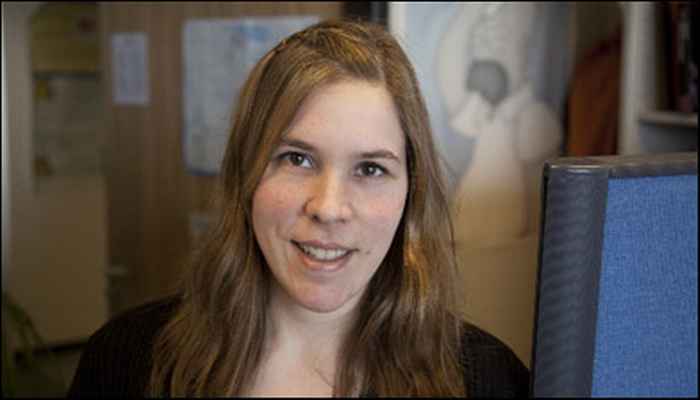Academic staff
Chemistry (MSc)

Name: Dr. Jocelyne Vreede
'My simulations of protein unfolding need computing power - lots of computing power. My calculations concern molecules made up of 30,000 atoms that change shape over the course of a million little steps. So that takes rather a lot of computing power.'
'When I first started studying chemistry I had never even worked on a computer. I was still writing up all my papers by hand. And I had never imagined myself in a research job involving entire days spent building models. It was lab work I wanted to pursue. But I enrolled in a few subjects dealing with molecular simulations and enjoyed them so much that I wanted to keep going in that direction.'
'After I obtained my PhD in the Microbiology research group at SILS (Swammerdam Institute or Life Sciences), I started working as a postdoc researcher in the Computational Physics and Chemistry group at HIMS (Van 't Hoff Institute for Molecular Sciences). My work there focused on a bacterial protein called Photoactive Yellow Protein, or PYP for short. The way this protein behaves is an illustration of observing signals on a molecular scale. PYP acts something like a trigger. It can detect harmful UV radiation and sets off a series of reactions in response. This response is prompted by a change in the protein's internal structure, which puts it into what is known as the signal state. Of course, the protein had already been sequenced, and various experiments had also revealed exactly how the protein was folded in space.'
'When you have a set of particles, they "feel" each other, as it were. I describe each bond, the angle of the atoms' placement relative to each other and the torsions. Next, I factor in the electrostatic interactions - positively charged particles repel each other; positive and negative attract - and the Van der Waal interactions, which quickly decay as distance grows. The result is a model which I refer to as a ‘force field': an extensive set of interactions between the particles inside the molecule.'
'It takes no more than a few milliseconds for PYP to unfold. The structural changes that occur are modelled on the basis of the force field description and use increments of femtoseconds. That means I would need to make around 1011 calculations to reconstruct the entire process of unfolding - not exactly time-efficient, considering that if it took me one second to do each increment, the entire calculation would take 15,000 years. Luckily, there are a few tricks I can use to speed up the reaction, such as using a higher temperature. For a protein like PYP to unfold, there has to be some sort of activation pushing it to cross the barrier from a stable state. That barrier is lower at higher temperatures, when atoms move much faster. Consequently, the simulation of the unfolding speeds up significantly. I've set up 64 unfolding simulations for PYP, each at a different temperature. By switching these temperatures, I was able to reconstruct how the molecule would look if it had been unfolding at room temperature. In the final model, the light-activated group had moved to the protein's exterior and several helixes had uncoiled. A number of other researchers carried out additional experiments with a mutant of PYP to check whether this conformation was valid. This mutant protein has a more stable signal state, enabling my colleagues to study it using an experimental technique. Their findings validate the PYP conformation I found.'
'But one major question remained: What is the actual course of the unfolding process? To find out, I used a method called Transition Path Sampling. This is a simulation technique designed around 10 years ago by my group's head researcher, Prof. Peter Bolhuis, whilst working at Berkeley. It starts off on a reaction path from another simulation, in this case a high temperature unfolding. Naturally that's not the real reaction path, but it is a reasonable guess. New reaction paths can also be calculated on the basis of this reaction path at any given point in the conformational change. The algorithm automatically saves the reaction paths that would put the protein in either the inactive or signal state. Reaction paths leading nowhere are rejected by the program. The successful reaction paths can be used to generate new paths in turn, with the process repeating until a path representing the probable unfolding is found. With 125 amino acids, PYP is a comparatively large protein to use in simulations, as it unfolds in a series of steps. Moreover, it is a molecule that is biologically relevant. My article on the unfolding even made it into the columns of the reputable journal Proceedings of the National Academy of Sciences (PNAS).'
'I have now widened my focus to include transitions in biological proteins that are even larger and more complex than PYP. In 2008 I received a Veni grant from the Netherlands Organisation for Scientific Research (NWO) for this research. One of my current projects is on so-called ‘coiled coils': two helix-shaped proteins that are coiled around each other.'
'It's logical that simulations do not always hit their mark right away. One of my programs might have a bug, for example, or I could make an error when inputting a bond. That's just as much a part of research as errors you make in the lab. It is the theory that is really key in this work. You always have to keep thinking about the chemical reality. Your steps have to be logical. In the end, a simulation program is never more than a tool.'